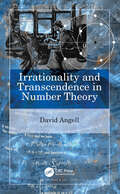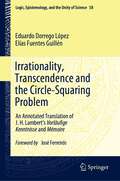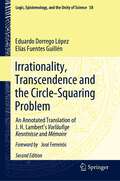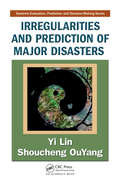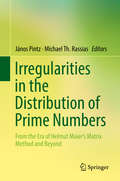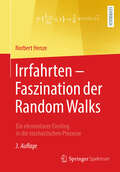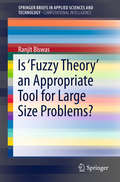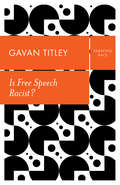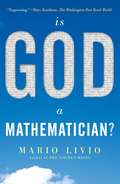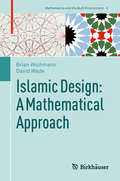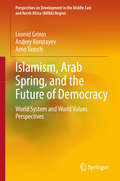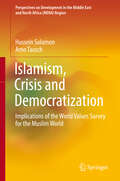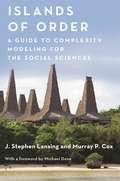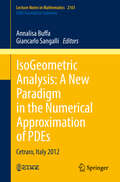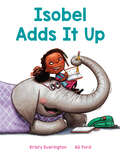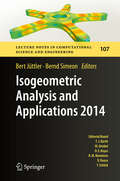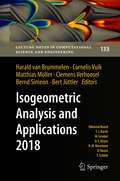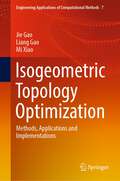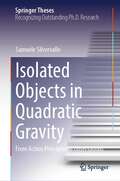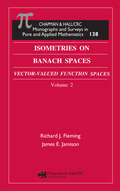- Table View
- List View
Irrationality and Transcendence in Number Theory
by David AngellIrrationality and Transcendence in Number Theory tells the story of irrational numbers from their discovery in the days of Pythagoras to the ideas behind the work of Baker and Mahler on transcendence in the 20th century. It focuses on themes of irrationality, algebraic and transcendental numbers, continued fractions, approximation of real numbers by rationals, and relations between automata and transcendence. This book serves as a guide and introduction to number theory for advanced undergraduates and early postgraduates. Readers are led through the developments in number theory from ancient to modern times. The book includes a wide range of exercises, from routine problems to surprising and thought-provoking extension material. Features Uses techniques from widely diverse areas of mathematics, including number theory, calculus, set theory, complex analysis, linear algebra, and the theory of computation Suitable as a primary textbook for advanced undergraduate courses in number theory, or as supplementary reading for interested postgraduates Each chapter concludes with an appendix setting out the basic facts needed from each topic, so that the book is accessible to readers without any specific specialist background
Irrationality, Transcendence and the Circle-Squaring Problem: An Annotated Translation of J. H. Lambert’s Vorläufige Kenntnisse and Mémoire (Logic, Epistemology, and the Unity of Science #58)
by Eduardo Dorrego López Elías Fuentes GuillénThis publication includes an unabridged and annotated translation of two works by Johann Heinrich Lambert (1728–1777) written in the 1760s: Vorläufige Kenntnisse für die, so die Quadratur und Rectification des Circuls suchen and Mémoire sur quelques propriétés remarquables des quantités transcendentes circulaires et logarithmiques. The translations are accompanied by a contextualised study of each of these works and provide an overview of Lambert’s contributions, showing both the background and the influence of his work. In addition, by adopting a biographical approach, it allows readers to better get to know the scientist himself. Lambert was a highly relevant scientist and polymath in his time, admired by the likes of Kant, who despite having made a wide variety of contributions to different branches of knowledge, later faded into an undeserved secondary place with respect to other scientists of the eighteenth century. In mathematics, in particular, he is famous for his research on non-Euclidean geometries, although he is likely best known for having been the first who proved the irrationality of pi. In his Mémoire, he conducted one of the first studies on hyperbolic functions, offered a surprisingly rigorous proof of the irrationality of pi, established for the first time the modern distinction between algebraic and transcendental numbers, and based on such distinction, he conjectured the transcendence of pi and therefore the impossibility of squaring the circle.
Irrationality, Transcendence and the Circle-Squaring Problem: An Annotated Translation of J. H. Lambert’s Vorläufige Kenntnisse and Mémoire (Logic, Epistemology, and the Unity of Science #58)
by Eduardo Dorrego López Elías Fuentes GuillénThis publication, now in its second edition, includes an unabridged and annotated translation of two works by Johann Heinrich Lambert (1728–1777) written in the 1760s: Vorläufige Kenntnisse für die, so die Quadratur und Rectification des Circuls suchen and Mémoire sur quelques propriétés remarquables des quantités transcendentes circulaires et logarithmiques. The translations, as in the first edition, are accompanied by a contextualised study of each of these works and provide an overview of Lambert’s contributions, showing both the background and the influence of his work. In addition, by adopting a biographical approach, it allows readers to better get to know the scientist himself.Lambert was a highly relevant scientist and polymath in his time, admired by the likes of Kant, who despite having made a wide variety of contributions to different branches of knowledge, later faded into an undeserved secondary place with respect to other scientists of the eighteenth century. In mathematics, in particular, he is famous for his research on non-Euclidean geometries, although he is likely best known for having been the first who proved the irrationality of pi. In his Mémoire, he conducted one of the first studies on hyperbolic functions, offered a surprisingly rigorous proof of the irrationality of pi, established for the first time the modern distinction between algebraic and transcendental numbers, and based on such distinction, he conjectured the transcendence of pi and therefore the impossibility of squaring the circle.
Irregularities and Prediction of Major Disasters
by Yi Lin Shoucheng OuYangAlthough scientists have effectively employed the concepts of probability to address the complex problem of prediction, modern science still falls short in establishing true predictions with meaningful lead times of zero-probability major disasters. The recent earthquakes in Haiti, Chile, and China are tragic reminders of the critical need for
Irregularities in the Distribution of Prime Numbers: From the Era of Helmut Maier's Matrix Method and Beyond
by Michael Th. Rassias János PintzThis volume presents research and expository papers highlighting the vibrant and fascinating study of irregularities in the distribution of primes. Written by an international group of experts, contributions present a self-contained yet unified exploration of a rapidly progressing area. Emphasis is given to the research inspired by Maier’s matrix method, which established a newfound understanding of the distribution of primes. Additionally, the book provides an historical overview of a large body of research in analytic number theory and approximation theory. The papers published within are intended as reference tools for graduate students and researchers in mathematics.
Irregularity in Graphs (SpringerBriefs in Mathematics)
by Ping Zhang Gary Chartrand Akbar AliDie Theorie der regularen Graphen (The Theory of Regular Graphs), written by the Danish Mathematician Julius Petersen in 1891, is often considered the first strictly theoretical paper dealing with graphs. In the 130 years since then, regular graphs have been a common and popular area of study. While regular graphs are typically considered to be graphs whose vertices all have the same degree, a more general interpretation is that of graphs possessing some common characteristic throughout their structure. During the past several decades, however, there has been some increased interest in investigating graphs possessing a property that is, in a sense, opposite to regularity. It is this topic with which this book deals, giving rise to a study of what might be called irregularity in graphs. Here, various irregularity concepts dealing with several topics in graph theory are described, such as degrees of vertices, graph labelings, weightings, colorings, graph structures, Eulerian and Hamiltonian properties, graph decompositions, and Ramsey-type problems.
Irrfahrten – Faszination der Random Walks: Ein elementarer Einstieg in die stochastischen Prozesse
by Norbert HenzeMit diesem Buch gelingt dem Autor des bekannten Lehrwerkes Stochastik für Einsteiger auf geradezu spielerische Weise, den Leser mit zahlreichen überraschenden Zufallsphänomenen und Nicht-Standard-Grenzwertsätzen im Zusammenhang mit einfachen Irrfahrten und verwandten Themen zu fesseln. Das Werk besticht mit einer durchgängig problemorientierten, lebendigen Darstellung, zu der auch mehr als 100 anschauliche Bilder beitragen. Es wird immer wieder konkret Modellbildung betrieben, und die erhaltenen Ergebnisse werden ausführlich diskutiert und vernetzt. Studierende, die dieses Werk in Proseminaren zur Stochastik getestet haben, waren insbesondere vom Zusammenspiel von geometrischen Argumenten (Spiegelungsprinzip), Kombinatorik, elementarer Stochastik und Analysis fasziniert. Gegenüber der 2. Auflage wurde das Werk unter anderem um einen Abschnitt über das diskrete Dirichlet-Problem sowie ein Kapitel mit Ausblicken erweitert. Zudem ist das Kapitel über mathematische Hilfsmittel jetzt deutlich ausführlicher. 74 Übungsaufgaben mit Lösungen sowie 51 Selbstfragen, die am Ende des jeweiligen Kapitels beantwortet werden, helfen, den Stoff zu vertiefen. Diesem Zweck dienen auch zahlreiche Links auf Erklärvideos.
Is 'Fuzzy Theory' an Appropriate Tool for Large Size Problems?
by Ranjit BiswasThework in this book is based on philosophical as well as logical views on thesubject of decoding the 'progress' of decision making process inthe cognition system of a decision maker (be it a human or an animal or a birdor any living thing which has a brain) while evaluating the membership valueµ(x) in a fuzzy set or in an intuitionistic fuzzy set or in anysuch soft computing set model or in a crisp set. A new theory isintroduced called by "Theory of CIFS". The following two hypothesisare hidden facts in fuzzy computing or in any soft computing process :- Fact-1: A decision maker(intelligent agent) can never use or apply 'fuzzy theory'or any soft-computing set theory without intuitionistic fuzzy system. Fact-2 : The Fact-1 does notnecessarily require that a fuzzy decision maker (or a crisp ordinary decisionmaker or a decision maker with any other soft theory models or a decision makerlike animal/bird which has brain, etc. ) must be aware orknowledgeable about IFS Theory! The "Theory ofCIFS" is developed with a careful analysis unearthing the correctness of thesetwo facts. Two examples of 'decision making problems' with complete solutionsare presented out of which one example will show the dominance of theapplication potential of intuitionistic fuzzy set theory over fuzzy set theory,and the other will show the converse i. e. the dominance of theapplication potential of fuzzy set theory over intuitionistic fuzzy set theoryin some cases. The "Theory of CIFS" may be viewed to belong to the subjects :Theory of Intuitionistic Fuzzy Sets, Soft Computing, Artificial Intelligence,etc.
Is Behavioral Economics Doomed: The Ordinary Versus The Extraordinary
by David K. LevineIt is fashionable to criticize economic theory for focusing too much on rationality and ignoring the imperfect and emotional way in which real economic decisions are reached. All of us facing the global economic crisis wonder just how rational economic men and women can be. Behavioral economics — an effort to incorporate psychological ideas into economics — has become all the rage. <p><p> This book by well-known economist David K. Levine questions the idea that behavioral economics is the answer to economic problems. It explores the successes and failures of contemporary economics both inside and outside the laboratory. It then asks whether popular behavioral theories of psychological biases are solutions to the failures. It not only provides an overview of popular behavioral theories and their history, but also gives the reader the tools for scrutinizing them. <p> Levine’s book is essential reading for students and teachers of economic theory and anyone interested in the psychology of economics.
Is Free Speech Racist? (Debating Race)
by Gavan TitleyThe question of free speech is never far from the headlines and frequently declared to be in crisis. Starting from the observation that such debates so often focus on what can and cannot be said in relation to race, Gavan Titley asks why racism has become so central to intense disputes about the status and remit of freedom of speech. Is Free Speech Racist? moves away from recurring debates about the limits of speech to instead examine how the principle of free speech is marshalled in today’s multicultural and intensively mediated societies. This involves tracing the ways in which free speech has been mobilized in far-right politics, in the recycling of ‘race realism’ and other discredited forms of knowledge, and in the politics of immigration and integration. Where there is intense political contestation and public confusion as to what constitutes racism and who gets to define it, ‘free speech’ has been adopted as a primary mechanism for amplifying and re-animating racist ideas and racializing claims. As such, contemporary free speech discourse reveals much about the ongoing life of race and racism in contemporary society.
Is God a Mathematician?
by Mario LivioBestselling author and astrophysicist Mario Livio examines the lives and theories of history’s greatest mathematicians to ask how—if mathematics is an abstract construction of the human mind—it can so perfectly explain the physical world.Nobel Laureate Eugene Wigner once wondered about “the unreasonable effectiveness of mathematics” in the formulation of the laws of nature. Is God a Mathematician? investigates why mathematics is as powerful as it is. From ancient times to the present, scientists and philosophers have marveled at how such a seemingly abstract discipline could so perfectly explain the natural world. More than that—mathematics has often made predictions, for example, about subatomic particles or cosmic phenomena that were unknown at the time, but later were proven to be true. Is mathematics ultimately invented or discovered? If, as Einstein insisted, mathematics is “a product of human thought that is independent of experience,” how can it so accurately describe and even predict the world around us? Physicist and author Mario Livio brilliantly explores mathematical ideas from Pythagoras to the present day as he shows us how intriguing questions and ingenious answers have led to ever deeper insights into our world. This fascinating book will interest anyone curious about the human mind, the scientific world, and the relationship between them.
Is Math Real?: How Simple Questions Lead Us to Mathematics' Deepest Truths
by Eugenia ChengOne of the world&’s most creative mathematicians offers a &“brilliant&” and &“mesmerizing&” (Popular Science) new way to look at math—focusing on questions, not answers Winner of the Los Angeles Times Book Prize and a New Scientist Best Book of the Year Where do we learn math: From rules in a textbook? From logic and deduction? Not really, according to mathematician Eugenia Cheng: we learn it from human curiosity—most importantly, from asking questions. This may come as a surprise to those who think that math is about finding the one right answer, or those who were told that the &“dumb&” question they asked just proved they were bad at math. But Cheng shows why people who ask questions like &“Why does 1 + 1 = 2?&” are at the very heart of the search for mathematical truth. Is Math Real? is a much-needed repudiation of the rigid ways we&’re taught to do math, and a celebration of the true, curious spirit of the discipline. Written with intelligence and passion, Is Math Real? brings us math as we&’ve never seen it before, revealing how profound insights can emerge from seemingly unlikely sources.
Isaac Newton on Mathematical Certainty and Method (Transformations: Studies in the History of Science and Technology)
by Niccolo GuicciardiniAn analysis of Newton's mathematical work, from early discoveries to mature reflections, and a discussion of Newton's views on the role and nature of mathematics.Historians of mathematics have devoted considerable attention to Isaac Newton's work on algebra, series, fluxions, quadratures, and geometry. In Isaac Newton on Mathematical Certainty and Method, Niccolò Guicciardini examines a critical aspect of Newton's work that has not been tightly connected to Newton's actual practice: his philosophy of mathematics. Newton aimed to inject certainty into natural philosophy by deploying mathematical reasoning (titling his main work The Mathematical Principles of Natural Philosophy most probably to highlight a stark contrast to Descartes's Principles of Philosophy). To that end he paid concerted attention to method, particularly in relation to the issue of certainty, participating in contemporary debates on the subject and elaborating his own answers. Guicciardini shows how Newton carefully positioned himself against two giants in the “common” and “new” analysis, Descartes and Leibniz. Although his work was in many ways disconnected from the traditions of Greek geometry, Newton portrayed himself as antiquity's legitimate heir, thereby distancing himself from the moderns. Guicciardini reconstructs Newton's own method by extracting it from his concrete practice and not solely by examining his broader statements about such matters. He examines the full range of Newton's works, from his early treatises on series and fluxions to the late writings, which were produced in direct opposition to Leibniz. The complex interactions between Newton's understanding of method and his mathematical work then reveal themselves through Guicciardini's careful analysis of selected examples. Isaac Newton on Mathematical Certainty and Method uncovers what mathematics was for Newton, and what being a mathematician meant to him.
Islamic Design: A Mathematical Approach (Mathematics And The Built Environment Ser. #2)
by Brian Wichmann David WadeThis book deals with the genre of geometric design in the Islamic sphere. Part I presents an overview of Islamic history, its extraordinary spread from the Atlantic to the borders of China in its first century, its adoption of the cultural outlook of the older civilisations that it conquered (in the Middle East, Persia and Central Asia), including their philosophical and scientific achievements - from which it came to express its own unique and highly distinctive artistic and architectural forms. Part II represents the mathematical analysis of Islamic geometric designs. The presentation offers unlimited precision that allows software to reconstruct the design vision of the original artist. This book will be of interest to Islamic academics, mathematicians as well as to artists & art students.
Islamism, Arab Spring, and the Future of Democracy: World System and World Values Perspectives (Perspectives on Development in the Middle East and North Africa (MENA) Region)
by Leonid Grinin Andrey Korotayev Arno TauschThis book provides an in-depth analysis of public opinion patterns among Muslims, particularly in the Arab world. On the basis of data from the World Values Survey, the Arab Barometer Project and the Arab Opinion Index, it compares the dynamics of Muslim opinion structures with global publics and arrives at social scientific predictions of value changes in the region. Using country factor scores from a variety of surveys, it also develops composite indices of support for democracy and a liberal society on a global level and in the Muslim world, and analyzes a multivariate model of opinion structures in the Arab world, based on over 40 variables from 12 countries in the Arab League and covering 67% of the total population of the Arab countries. While being optimistic about the general, long-term trend towards democracy and the resilience of Arab and Muslim civil society to Islamism, the book also highlights anti-Semitic trends in the region and discusses them in the larger context of xenophobia in traditional societies. In light of the current global confrontation with radical Islamism, this book provides vital material for policy planners, academics and think tanks alike.
Islamism, Crisis and Democratization: Implications of the World Values Survey for the Muslim World (Perspectives on Development in the Middle East and North Africa (MENA) Region)
by Hussein Solomon Arno TauschThis book systematically assesses the value systems of active Muslims around the globe. Based on a multivariate analysis of recent World Values Survey data, it sheds new light on Muslim opinions and values in countries such as Indonesia, Iran, Tunisia, Egypt and Turkey. Due to a lack of democratic traditions, sluggish economic growth, escalating religiously motivated violence, and dissatisfaction with ruling elites in many Muslim countries, the authors identify a crisis and return to conservative values in the Muslim world, including anti-Semitism, religious and sexual intolerance, and views on democracy and secularism, business and economic matters. Based on these observations, they offer recommendations for policymakers and civil societies in Muslim countries on how to move towards tolerance, greater democratization and more rapid economic growth.
Islands of Order: A Guide to Complexity Modeling for the Social Sciences (Princeton Studies in Complexity #33)
by J. Stephen Lansing Murray P. CoxOver the past two decades, anthropologist J. Stephen Lansing and geneticist Murray Cox have explored dozens of villages on the islands of the Malay Archipelago, combining ethnographic research with research into genetic and linguistic markers to shed light on how these societies change over time. Islands of Order draws on their pioneering fieldwork to show how the science of complexity can be used to better understand unstable dynamics in culture, language, cooperation, and the emergence of hierarchies.Complexity science has opened exciting new vistas in physics and biology, but poses challenges for social scientists. What triggers fundamental, discontinuous social change? And what brings stable patterns—islands of order—into existence? Lansing and Cox begin with an incisive and accessible introduction to models of change, from simple random drift to coupled interactions, phase transitions, co-phylogenies, and adaptive landscapes. Then they take readers on a series of journeys to the islands of the Indo-Pacific to demonstrate how social scientists can harness these powerful tools to discover out-of-equilibrium social dynamics. Lansing and Cox address empirical questions surrounding the colonization of the Pacific, the relationship of language to culture, the emergence and disappearance of male and female hierarchies, and more.Unlocking new possibilities for the social sciences, Islands of Order is accompanied by an interactive companion website that enables readers to explore the models described in the book.
IsoGeometric Analysis: A New Paradigm in the Numerical Approximation of PDEs
by Annalisa Buffa Giancarlo SangalliProviding an introduction to isogeometric methods with a focus on their mathematical foundations, this book is composed of four chapters, each devoted to a topic of special interests for isogeometric methods and their theoretical understanding. It contains a tutorial on splines and generalizations that are used in CAD parametrizations, and gives an overview of geometric modeling techniques that can be used within the isogeometric approach, with a focus on non-tensor product splines. Finally, it presents the mathematical properties of isogeometric spaces and spline spaces for vector field approximations, and treats in detail an application of fundamental importance: the isogeometric simulation of a viscous incompressible flow. The contributions were written by Carla Manni and Hendrik Speelers, Vibeke Skytt and Tor Dokken, Lourenco Beirao da Veiga, Annalisa Buffa, Giancarlo Sangalli and Rafael Vazquez, and finally by John Evans and Thomas J. R. Hughes.
Isobel Adds It Up
by Kristy EveringtonMath-loving kids, especially those who are often bothered by loud noises, will be happy there aren't any elephants around.Isobel is a problem solver . . . addition, subtraction, multiplication, division! But trying to figure out who is causing all the noise next door is one problem she can't quite work out. Is it a marching band? A basketball team in the middle of a practice? Could it be a family of elephants?Isobel doesn't know what to do about all the noise, but the solution just might come from the most unlikely place!
Isogeometric Analysis and Applications 2014
by Bert Jüttler Bernd SimeonIsogeometric Analysis is a groundbreaking computational approach that promises the possibility of integrating the finite element method into conventional spline-based CAD design tools. It thus bridges the gap between numerical analysis and geometry, and moreover it allows to tackle new cutting edge applications at the frontiers of research in science and engineering. This proceedings volume contains a selection of outstanding research papers presented at the second International Workshop on Isogeometric Analysis and Applications, held at Annweiler, Germany, in April 2014.
Isogeometric Analysis and Applications 2018 (Lecture Notes in Computational Science and Engineering #133)
by Bert Jüttler Bernd Simeon Harald Van Brummelen Cornelis Vuik Matthias Möller Clemens VerhooselThis proceedings volume gathers a selection of outstanding research papers presented at the third Conference on Isogeometric Analysis and Applications, held in Delft, The Netherlands, in April 2018. This conference series, previously held in Linz, Austria, in 2012 and Annweiler am Trifels, Germany, in 2014, has created an international forum for interaction between scientists and practitioners working in this rapidly developing field. Isogeometric analysis is a groundbreaking computational approach that aims to bridge the gap between numerical analysis and computational geometry modeling by integrating the finite element method and related numerical simulation techniques into the computer-aided design workflow, and vice versa. The methodology has matured over the last decade both in terms of our theoretical understanding, its mathematical foundation and the robustness and efficiency of its practical implementations. This development has enabled scientists and practitioners to tackle challenging new applications at the frontiers of research in science and engineering and attracted early adopters for this his novel computer-aided design and engineering technology in industry. The IGAA 2018 conference brought together experts on isogeometric analysis theory and application, share their insights into challenging industrial applications and to discuss the latest developments as well as the directions of future research and development that are required to make isogeometric analysis an established mainstream technology.
Isogeometric Topology Optimization: Methods, Applications and Implementations (Engineering Applications of Computational Methods #7)
by Jie Gao Liang Gao Mi XiaoThis book provides a systematic description about the development of Isogeometric Topology Optimization (ITO) method using the density, and then addresses the effectiveness and efficiency of the ITO method on several design problems, including multi-material structures, stress-minimization structures, piezoelectric structures and also with the uniform manufacturability, ultra-lightweight architected materials with extreme bulk/shear moduli, auxetic metamaterials and auxetic meta-composites with the NPRs behavior in microstructures. A detailed MATLAB implementation of the ITO method with an in-house code “IgaTop” is also presented.
Isolated Objects in Quadratic Gravity: From Action Principles to Observations (Springer Theses)
by Samuele SilvervalleOne of the main unanswered question of modern Physics is "How does gravity behave at small scales?". The aim of this thesis is to illustrate in a comprehensive but accessible way how to look for deviations from Einstein's theory of General Relativity in this regime, looking at the simplest celestial bodies: static and spherically symmetric ones.With a conservative and bottom-up approach, at smaller scales the first corrections to the action of General Relativity are generally considered to be terms quadratic in the curvature tensors; while these modifications do not cure the inconsistency between gravity and quantum mechanics, the solutions of this theory are plausible candidates to be the first-order corrections of the classical ones.Even with such simple modifications, a striking picture emerges from the study of isolated objects: the unique Schwarzschild solution of General Relativity is only a rare bird in the set of solutions, with non-Schwarzschild black holes, wormholes and naked singularities appearing as possible substitutes.Tailored to graduate students and researchers entering this field, this thesis shows how to construct these new solutions from action principles, how to characterize their metric, how to study their physical properties, such as their stability or Thermodynamics, and how to look for phenomenological signatures.
Isolated Singularities in Partial Differential Inequalities
by Marius Ghergu Steven D. TaliaferroIn this monograph, the authors present some powerful methods for dealing with singularities in elliptic and parabolic partial differential inequalities. Here, the authors take the unique approach of investigating differential inequalities rather than equations, the reason being that the simplest way to study an equation is often to study a corresponding inequality; for example, using sub and superharmonic functions to study harmonic functions. Another unusual feature of the present book is that it is based on integral representation formulae and nonlinear potentials, which have not been widely investigated so far. This approach can also be used to tackle higher order differential equations. The book will appeal to graduate students interested in analysis, researchers in pure and applied mathematics, and engineers who work with partial differential equations. Readers will require only a basic knowledge of functional analysis, measure theory and Sobolev spaces.
Isometries in Banach Spaces: Vector-valued Function Spaces and Operator Spaces, Volume Two (Monographs and Surveys in Pure and Applied Mathematics)
by Richard J. Fleming James E. JamisonA continuation of the authors' previous book, Isometries on Banach Spaces: Vector-valued Function Spaces and Operator Spaces, Volume Two covers much of the work that has been done on characterizing isometries on various Banach spaces.Picking up where the first volume left off, the book begins with a chapter on the Banach-Stone property.
